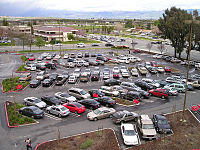
Photo from wikipedia
In the present study, Landsat series remote sensing image are utilized to investigate the spatial and temporal changes of the urban heat island (UHI) in the Taiyuan city from 1990,… Click to show full abstract
In the present study, Landsat series remote sensing image are utilized to investigate the spatial and temporal changes of the urban heat island (UHI) in the Taiyuan city from 1990, 2004 and 2014. The main influencing factors of the UHI are analyzed in this regard. The single window algorithm is adopted to invert the land surface temperature (LST) from the thermal infrared data and analyze the spatiotemporal pattern of the LST in the studied area. Then, the urban thermal field variance index (UTFVI), normalized difference vegetation index (NDVI) and biophysical composition index (BCI) are calculated in accordance with the LST. Moreover, the degree of impervious surface of the study area is divided according to the BCI value. By analyzing the correlation between the LST, NDVI and the BCI, the influences of two major factors, green space and impervious surface, on urban heat islands are discussed. It is found that the average surface temperature of the Taiyuan city has increased by 5.17 °C during the past 24 years from 1990 to 2014, while the impervious surface area has increased by 223.53 km2, which is 1.179 times of that in 1990. There is a statistical correlation between the LST and the data of the NDVI and impervious surface, which shows that the reduction in green space and the increase in impervious surface in the city have a significant impact on the urban heat island effect. As the largest city in Shanxi province, there is an increasing demand in Taiyuan city for constructing lands during the urbanization process, which has led to a remarkable decrease in the green space and an increase in impervious surfaces. Therefore, the LST in Taiyuan city has been affected by the rapid urbanization. Furthermore, UTFVI indicates that the overall ecological environment of the Taiyuan city has deteriorated and the area of high temperature in the city has increased significantly. Results of the present study may provide a scientific basis for government departments to formulate urban planning and environmental protection policies. The present study may help the government to expand urban green spaces in the right places, control the expansion of the impervious surface of the city, alleviate the UHI effect and maintain the sustainable development of the Taiyuan city.
Journal Title: Environment, Development and Sustainability
Year Published: 2020
Link to full text (if available)
Share on Social Media: Sign Up to like & get
recommendations!